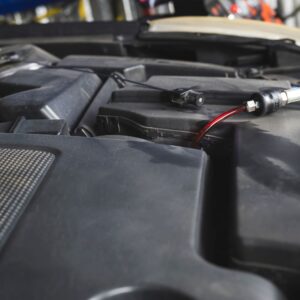Automatic transmissions are supposed to shift seamlessly between gears. Electronic transmissions will often even de-torque the engine at the moment of a transmission shift to make it shift even smoother.
When a driver is accelerating calmly, they shouldn’t be able to discern the shifts. However, automatic transmissions can develop issues that can cause them to have harsh and jerky shifts. The transmission can also make clunking noises.
Unwanted hard shifting can be frustrating for a driver and passenger since it can make for an unpleasant riding experience.
Causes of a Hard-Shifting Automatic Transmission
Low or Dirty Transmission Fluid
Having low or dirty transmission fluid is the most common reason for an automatic transmission shifting hard. Low transmission fluid will cause the transmission not to engage when it is first put in gear and since you’ll be applying the throttle, when it finally does engage, it’ll be very harsh.
Dirty or worn-out transmission fluid can create blockages and deposit varnish on valves in the valve body, which directs fluid to clutches, brakes, servos, etc., causing the transmission to shift improperly.
If the transmission overheats, it will emit a burnt smell and can even cause smoke. As much as possible, you shouldn’t let your transmission overheat since this will result in severe damage.
Faulty Transmission Speed Sensors
Transmission speed sensors are responsible for detecting the speed of a transmission input and output shaft. Some transmissions also have an intermediate shaft sensor. The engine and transmission control module (TCM) need information from these sensors for proper shifting.
More importantly, the TCM needs information from the speed sensor to determine the correct shift timing. Without knowing the precise input and output shaft speeds, the transmission might not be able to shift properly, which will result in harsh shifts. If the output sensor isn’t working, sometimes it may prevent the transmission from shifting out of low gear.
Faulty Transmission Solenoids
The transmission’s shift solenoids are plungers that push transmission fluid through the gearbox’s channels. The fluid is directly responsible for moving the key transmission components to shift gears. A transmission has several of these solenoids. When some solenoids fail or malfunction, the transmission can have issues that include harsh shifting.
Faulty Valve Body
The transmission valve body is a set of channels and passages that direct transmission fluid to its appropriate locations.
Over time, heat, pressure, and fluid contamination can wear out the valve body. The fluid channels can eventually warp and become oversized. Since the valve body plays such a huge role in gear shifting, it’s logical that a faulty valve body can cause rough shifting.
Vacuum Issues
Older vehicles rely on a vacuum modulator valve to determine shift timing. Low vacuum means high load, which calls for late, hard shifts. When the vacuum lines leading to the engine’s intake manifold are either bent, blocked, or detached, the altered pressure can cause the transmission to have rough shifts.
How to Fix a Hard-Shifting Automatic Transmission
As previously mentioned, several faulty components can cause these transmission issues. Your first course of action should be to identify the faulty component.
Your vehicle’s on-board diagnostic (OBD) system is designed to help you diagnose any transmission issues. This system stores trouble codes when the vehicle’s computer detects irregularities from transmission sensors or other electronic parts. If you have a faulty sensor, low transmission fluid, or a bad solenoid, the OBD system will store a trouble code that corresponds to that issue.
To fix the issue, you’ll need to use a scan tool to identify the stored codes and resolve them. If your vehicle stored a code that indicates that it has low or dirty transmission fluid, then you’ll need to top up or replace the transmission fluid.
Remember that a vehicle’s transmission fluid needs to be changed at a regular interval indicated by the owner’s manual. Depending on the vehicle, this interval can be anywhere from 30,000 to 60,000 miles.
Sometimes, a computer error can cause a hard-shifting transmission. When this is the case, resetting the computer by disconnecting the battery for an hour can fix the issue.
Aside from the fixes mentioned above, there aren’t many DIY solutions when it comes to addressing transmission problems because accessing the transmission is a difficult task. To solve most transmission problems, you’ll need the help of a trustworthy mechanic, as repairing these issues can be quite complicated.
Have a transmission issue? You should have it checked immediately since transmission problems can worsen and result in transmission damage, which is expensive to repair.
When Hard Shifting is a Good Thing
Older automatic transmissions (except for Chryslers, which used a piece of linkage connected to a throttle valve on the transmission) had a modulator valve on the outside of the transmission or transaxle with a diaphragm connected to engine vacuum so that when the engine is loaded heavily (like driving up a hill or pulling a heavy trailer), low vacuum at the modulator valve would move a spool valve inside the valve body to increase line pressure, which increases the time between shifts and enables the clutches to apply with more force when the shift happens.
This is necessary to protect the clutches in the transmission. If for some reason the vacuum line to the modulator valve became disconnected, the transmission would shift late and hard.
Vacuum-operated modulator valves went away in the late 1990s on just about all vehicles and were replaced with throttle valve cables that operated a valve in the transmission or transaxle.
On these platforms, if the shift cable is maladjusted or stuck, the transmission will shift late and hard, or just hard in some cases. If the linkage or cable is left disconnected or comes loose, normal driving and the resulting soft shifts will destroy the clutches in the transmission.
Finally, mechanical throttle valve linkages have been replaced with a variable force electronic pressure control valve that responds to a duty cycle current from the TCM or PCM based on throttle angle and load as measured by the sensors on the engine. That valve raises the pressure when it’s supposed to be high and lowers the line pressure when it should be low.
Electronic transmissions and transaxles also have pressure switches or transducers and shift control solenoids.
The pressure control valves in modern transmissions are designed to default to high pressure if they lose power or even if the TCM/PCM detects that there is transmission or torque converter slippage. In this case, the higher pressure prevents the clutches in the transmission from totally burning out. A hard shift needs to be investigated if it happens during gentle driving cycles (no hard acceleration or heavy load), but it’s not as likely to cause damage as it might seem.
Any information provided on this Website is for informational purposes only and is not intended to replace consultation with a professional mechanic. The accuracy and timeliness of the information may change from the time of publication.




































